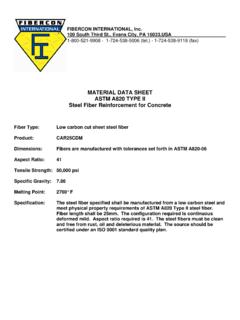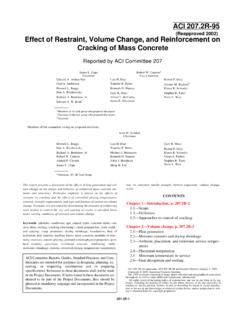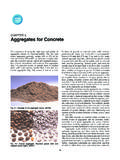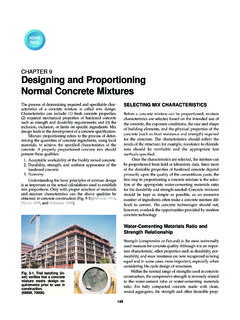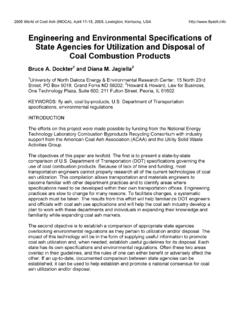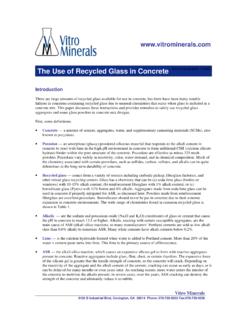Transcription of FAQ’S: Steel Fiber Reinforced Concrete
1 FAQ S: Steel Fiber Reinforced Concrete What is Steel Fiber Reinforced Concrete (SFRC)? SFRC is a composite material made of hydraulic cements, water, fine and coarse aggregate, and a dispersion of discon-tinuous, small fibers. It may also contain pozzolans and admixtures commonly used with conventional Concrete . All admixtures meeting ASTM specifications for use in con-crete are suitable for use in SFRC. Calcium chloride and chlorides from other sources should be limited to amounts permitted to be added to conventional structural Concrete as shown in ACI 318. What is the function of Steel fibers in con-crete? Unlike welded wire reinforcement or rebar, which is specifically located in a sin-gle plane, Steel fibers are distributed uni-formly throughout the Concrete matrix.
2 The primary function of Steel fibers is to modify micro and macro cracking. By intercepting cracks at their origin, the Steel fibers inhibit crack growth. For this reason, SFRC can be used to replace welded wire reinforcement or rebar which is used to control temperature or shrinkage cracks. What is the function of micro synthetic fibers? Synthetic fibers have been shown to reduce the formation of plastic-shrinkage and settlements cracks at the surface by increas-ing the tensile strain capacity of the plastic Concrete . These fibers should not be used to replace temperature and shrinkage reinforce-ment because they have little impact on the behavior of Concrete after it hardens.
3 Where can Steel fibers be added to the Concrete ? Steel fibers can be introduced into the Concrete at the batch plant or jobsite. Consult Fibercon Fact Mixing, Placing and Finishing for more details on the proper methods of adding fibers to Concrete . Can SFRC be pumped? Pumping has been used to transport SFRC on many projects. In general a mixture that will pump satisfacto-rily without fibers will pump with fibers. In pumping SFRC, the chute from the ready-mix truck should be 12 above the grate on the hopper. This will prevent the Fiber from bridging the gaps in the grate and ensure a steady flow of Concrete to the pump. The grate should never be removed from the hop-per.
4 Can shake-on-toppings or liquid harden-ers be applied over a SFRC floor? Both can be used on a SFRC floor. Shake-on-toppings can act as a Fiber suppressor and limit the number of fibers on the surface. If liquid hardeners are used the floor should be moist cured for 7 days and allowed to air dry per manufacturer s recommendations before installing the liquid hardener. FAQ S: Steel Fiber Reinforced Concrete What depth should saw cuts be in a SFRC floor? Contraction joints can be installed using either a wet saw or an early entry saw. For wet saws the depth should be the depth for slabs less than 6 thick. For slabs over 6 thick or slabs with over 40 pounds of Steel Fiber per cubic yard of Concrete , the saw cuts should be the depth.
5 For early entry saws, the manufacturer s recommendation should be followed. Can SFRC replace Concrete with welded wire reinforcement or rebar? WRI states in Tech Facts 705 that two of the primary purposes for reinforcing slabs-on-ground are for shrinkage and temperature control. SFRC is an economical way of controlling cracks due to changes in temperature or vol-ume changes as the Concrete ages. For WWR or rebar to control these cracks posi-tioning is important. Positioning is important when using WWR or rebar. WRI states that when on layer of reinforcement is used, it should not be allowed to be below mid-depth. In general, positioning at the depth below the surface is sufficient.
6 This is ex-tremely difficult with the common practice of using a LaserScreed to strike-off the Concrete . This problem is eliminated with the use of SFRC since the fibers are ran-domly distributed throughout the Concrete . Do Steel fibers ball up when mixing? When fibers were first introduced balling was an issue due to the high aspect ratio and long length. Our standard fibers have aspect ratios of less than 50 and are 1 in length. As the aspect ration increases above 50 and the length exceeds 2 , the tendency to ball increases. This is the reason some of our competitors must collate their fibers to re-duce the chances of Fiber balls.
7 Can SFRC be used with a wire guidance system? WGV follow a cable imbedded into the floor. For imbedded Steel to affect the wire guidance the mass of Steel must be sub-stantial and it must lie very close almost touching- the wire. Small randomly distrib-uted Steel fibers do not meet the conditions that would cause trouble for the wire guid-ance. Steel fibers have been used success-fully on many of the VNA applications.

